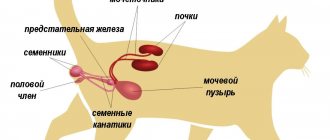Save the article:
A cat that lives at home periodically “delights” its owners with loud, heart-rending screams, signaling the onset of mating season. With its behavior at this time, any, even the best cat in the world is capable of wearing out the entire nervous system of the household. There is a solution to this problem that will save the owner from the animal’s inappropriate behavior and its consequences - this is castration of the cat .
Castration is a surgical or non-surgical intervention in a male’s body to remove the gonads. The procedure has both advantages and disadvantages, because in any case it will affect the future quality of life of both the cat and its owners.
Pros and cons of castration
global $ads_google; //data-ad-slot=”2475549904″ $ads_google = empty($ads_google) ? false : true; ?> if ($ads_google == false) {?>
$ads_google = true; ?> } ?>
Often the reason for castration of a cat is not only his urgent demand to continue his family, but also an active desire to mark territory. To prevent the furry friend from causing such problems, an operation is performed.
This leads to obvious advantages of the procedure:
- there is no reason to mark territory;
- no excessive aggression;
- absence of loud demands from the cat;
- reducing the risk of genitourinary diseases;
- increasing lifespan.
We must not forget about the disadvantages :
- It is possible that a cat with loss of gonads acquires an increased appetite. This can lead to obesity and health problems;
- perhaps due to changes in hormonal balance, a decrease in the activity of the animal, which is also fraught with obesity;
- when performing surgery on adults or elderly males, sometimes difficulties arise with the functioning of the cardiovascular system;
- if castration was carried out at the wrong time, then not only the testes, but also the pituitary gland take over the production of sex hormones: the operation becomes useless, and all the “cute” manifestations of the mating season continue.
But if the animal is healthy, the cat is castrated at the appropriate time, and the owners strictly monitor the pet’s balanced diet, the disadvantages do not manifest themselves.
Optimal age for castration
It is very important to perform castration in a timely manner so that this procedure does not have negative consequences for the cat’s health and at the same time maintains its effectiveness. A pet is considered ready for such a serious operation if it meets two basic conditions:
- The cat has recently reached puberty. Veterinarians advise castrating those cats that have not yet participated in mating. Otherwise, even the removal of some reproductive organs will not lead to the desired result: the pet will still be focused on finding a female;
- the cat’s body has completed its physiological development, in other words, your pet has finally formed. Since castration radically changes metabolic processes in the body, it negatively affects young cats that have not had time to grow up, further slowing down the development of the animal.
Only those cats whose bodies have had time to form are subject to castration.
If we talk about more specific time frames, then the earliest age at which castration can already be carried out is six months. The boundaries of the latest age are blurred. Some owners castrate their pets at 2, 3, and even 4 years old, but veterinarians advise this operation to be performed on cats up to a year old.
It should also be kept in mind that different breeds require different rates of development. Representatives of large breeds experience anesthesia more easily due to their greater weight (castration is carried out on pets that have reached a minimum body weight of two kilograms). However, the lower threshold of six months does not mean that as soon as your cat is six months old, he should immediately be taken to the vet for surgery.
In different breeds, the onset of physiological and sexual maturity may occur at different times.
The best solution when choosing the appropriate age for castration would be to prefer the golden mean, which involves removing the gonads in animals between the ages of 8 and 10 months. It is at this time that cats complete the formation of all anatomical structures, and their health is sufficiently strengthened to tolerate anesthesia well.
How to determine whether a cat is ready for castration?
The veterinarian himself can suggest the appropriate age for castration when examining the animal. The fact is that, in addition to age criteria, there is also anatomical criteria. A signal that the pet is ready for castration is the prolapse of the testes, which can occur at different times in different individuals.
Before performing the operation, the veterinarian always assesses the cat’s readiness for castration.
Until descent, the testes are located either in the abdominal cavity or in the inguinal ring. This means that even with the strong desire of the owners, the veterinarian simply will not be able to perform surgical intervention. However, a feature of cat physiology is that puberty in these animals precedes the actual physiological one. This suggests that even after the testicles have descended, it is advisable for animal owners to wait one or two months and only then take the cat for castration.
Video - When is the best time to castrate a cat?
When to castrate a cat
To answer the question about the appropriate time for castration, you need to understand when the organs and systems of the body complete their formation.
This happens at about one year, but physiologically the cat becomes sexually mature at six months. Therefore, 6 months is the earliest time to castrate a cat.
.
If the operation is performed before six months, then there is a high probability that the cat will develop urolithiasis (this is especially true for Persians, Himalayan cats, British cats and Scottish Fold breeds), because the urethra is not fully formed. The testes of some males at this age may still not be in place, and this is a significant problem for surgical castration.
You don’t have to wait long: the procedure performed at the age of 7-9 months is easier and more successful.
In any case, a preliminary consultation at a veterinary clinic is required.
The scary word "castration"
As a rule, when acquiring a furry cat, people rarely think about the fact that in a few months it will grow into a mature cat, whose body will require the satisfaction of natural needs. An uncastrated cat means round-the-clock, far from euphonious “concerts.” It is unlikely that you will be able to force a “wanting” cat to stop yelling and meowing, and the resulting increase in hormonal levels also causes hair shedding, loss of appetite, and even a complete refusal to eat.
In addition, uncastrated cats often become aggressive during the rut - they rush at people, scratch and bite. The most unpleasant thing is that at this time animals mark their territory with an enzyme secreted by special glands. It is impossible to get rid of the smell they leave in every corner.
Things marked with a cat are practically impossible to wash and clean.
A simple operation to remove the testes - castration - will help get rid of these problems. Some owners do not castrate cats “out of pity”, so as not to deprive their tailed friend of pleasure. In fact, it is merciless to deprive a healthy, adult cat of a female. In addition to exhaustion and nervousness, this threatens serious illnesses - prostatitis, adenoma of the perianal glands.
After castration, the animal stops producing male hormones, sexual activity decreases, and the instinct to procreate disappears. However, the operation does not affect the other behavioral functions of the animal: the cat remains playful, becomes more attached to its owners and feels the fullness of life.
Thus, by castrating a cat, owners solve problems associated with the animal’s sexual behavior.
Don't confuse castration with sterilization. During sterilization (vasectomy), the testes of cats are not removed, which means that hormones continue to be produced and the genitals are preserved. The cat becomes “sterile”, retaining its instincts and feline libido. Animals are able to mate.
When is castration necessary?
There are mandatory medical indications for the operation:
- genital injuries;
- pathologies of the reproductive organs of the animal, for example, orchitis (inflammation of the testes);
- urinary incontinence;
- excessive aggression;
Castration reduces the animal's aggressiveness
- genetic diseases.
In these cases, castration is carried out at any age.
Castration is also recommended for cryptorchidism (failure of the testes to descend into the scrotum). The operation in this case looks a little more complicated and consists of two stages (if one testicle is undescended - the most common variant of the disease):
- first, the undescended testis is cut off,
- then the healthy one is removed - as during normal castration.
Breeders breed purebred pet-class kittens, which means “house pet.” The breeding of such animals is not encouraged and they are castrated at an early age - 3-4 months.
Optimal age
Most veterinarians believe that cats need to be castrated at 7–9 months of age: by this time the body is formed, sufficient body weight has been gained, but puberty has not yet been completed, and hormones are produced only in the testes (after 12 months, sex hormones also begin to be produced pituitary).
It is believed that cats are neutered before the age of seven. If you decide to castrate a cat whose body has begun to age, you risk losing your furry pet. The risk of complications increases with age: the heart may not tolerate anesthesia.
Once upon a time it happened that I had to pick up a shabby cat on the street. Recaptured from a pack of stray dogs. The veterinary clinic helped him. Age was determined to be 7–8 years. When the topic of “adoption” came up, the question of castration arose. Doctors warned of a possible fatal outcome for the cat. But we took a risk. And for good reason. Timokha lived another 11 years and died quietly of old age.
Types of castration
Surgical and non-surgical methods are used.
Surgical methods:
- Open method - the scrotum is greatly stretched and an incision is made. The testis is removed, the vaginal membrane is freed from it using scissors. The spermatic cord is removed and tied to itself. The same is done with the second testis, after which they are removed.
- With the closed method, the tunica vaginalis is not opened, but only an incision is made to remove the testis and the tunica vaginalis from the scrotum. A ligature is applied to the spermatic cord and cut off. The skin of the scrotum is not sutured.
- The bloodless method or castration without removing the testicles consists of squeezing the spermatic cords with special forceps, after which, after 5 months, they are reabsorbed.
- Vasectomy is a gentle method of sterilization: the seminiferous tubules are partially destroyed, which serves as an obstacle to sperm entering the penis. The testes continue their work, and the cat continues to demand a female, but cannot continue the race.
Non-surgical methods do not involve removing the testicles. This includes chemical castration in the form of injections, tablets or the introduction of a Suprelorin implant.
At what age can a kitten be neutered?
Surprisingly, such a not new and common operation as castration of domestic animals has been studied very little. There is virtually no scientific data regarding the optimal age for neutering cats or dogs.
For a long time, veterinarians recommended that cats be castrated between 6 months and 1 year of age. During this period, the animal begins puberty: in females the first estrus comes, in males the testes descend into the scrotum. The most obvious reason for this recommendation is the convenience of the operation: the organs of the reproductive system are quite large, the body is full of strength. However, if there is oversight on the part of the owner, a cat can already produce its first offspring at 8-10 months, which will have a bad effect on its further growth and development.
In foreign practice, earlier periods of castration are often recommended. This is largely due to the problems associated with the large number of stray animals and the need to control their birth rate. Many shelters in the United States and Canada now perform neutering surgeries for puppies and kittens before puberty, between 8 and 16 weeks of age. Breeders from these countries also began contacting veterinarians about early castration. Some of them prefer to sell pet-class kittens and puppies already neutered, which relieves some of the worries from their future owners.
Preparing a cat for castration
Careful preparation of the animal is mandatory: the success of the operation largely depends on this. If you ignore the veterinarian’s instructions, you may experience health complications and, as a result, additional financial losses.
It is important to follow a strict diet, as anesthesia can cause a gag reflex. The male is not fed for 10-12 hours before the start of the procedure, which will prevent vomit from entering the respiratory tract. Water is not given 4-6 hours before surgery.
global $ads_google; //data-ad-slot=”2475549904″ $ads_google = empty($ads_google) ? false : true; ?> if ($ads_google == false) {?>
$ads_google = true; ?> } ?>
The cat should not have any diseases or health problems that could be a contraindication to castration.
A week before the operation, the cat is dewormed, and the day before it is washed with zoo shampoo.
General information about the procedure
Castration of a cat is an operation to remove the testes and suppress the sexual function of the pet.
There are several methods for carrying out the procedure:
- Surgical (or classical). Most cat owners in Russia resort to this method of castration.
- Chemical. A chemical composition is injected into the testes. It destroys the glands, and they are replaced by connective tissue elements. Veterinarians consider this method simple and cheap. However, it has not yet found application in Russia.
- Medical sterilization is the implantation of implants under the skin of a cat. They secrete a drug that completely suppresses the cat’s sexual function. This type of castration is not cheap, but it is absolutely safe for your pet’s health.
- Radiation castration. The cat's testes are placed under a source of gamma radiation to suppress sexual function. The method is reliable, safe for the health of the animal and simple in technique. To carry it out, you will need special equipment, which is not available in all clinics, so the cost of the procedure will be high. Complications are extremely rare. In addition, the cat does not need to undergo either general anesthesia or local anesthesia.
Pros of the operation
Veterinarians believe that this procedure is necessary for animals that will not be used in breeding activities. The owner must study all the advantages of the operation and possible consequences and make an independent decision.
Benefits of the procedure:
- increasing the life expectancy of a pet;
- reducing the risk of developing oncology and diseases of the genitourinary system;
- the pet’s character becomes more balanced;
- getting rid of obsessive and loud meowing;
- cats no longer mark territory;
- suppressing the cat's desire to run away from home in search of a partner.
Negative consequences
During or after the procedure, your pet may experience various complications:
- sudden weight gain due to a slowdown in metabolism in the body;
- development of urolithiasis;
- suture infection;
- pain at the incision site;
- bleeding from the suture;
- disruption of the gastrointestinal tract.
Castration can be fatal, so the operation is prohibited for cats with the following diseases:
- renal failure;
- urolithiasis disease;
- cardiopulmonary failure;
- liver diseases.
Important! Sometimes neutered cats continue to mark their territory after the procedure.
Castrate a cat at home
Like spaying a cat, neutering can be done at home.
The arriving veterinarian does an examination and, in case of problems, gives answers to all questions. If there are no contraindications, the cat is given anesthesia. After it comes into force, the operation begins and lasts up to 20 minutes.
Then the animal comes out of anesthesia, and the veterinarian once again advises the owners about possible difficulties and gives recommendations for caring for the cat after the operation.
Is it possible to castrate at a later age?
Some owners did not decide in time to carry out this procedure on the animal, but later came to the conclusion that castration was necessary. This begs a completely reasonable question: is it possible to perform it on an adult cat, one year old or more?
Veterinarians approve of this decision, but in some cases they still warn about possible risks for the animal. Relatively safe castration can be performed on a cat from one to seven years of age. But this operation is not recommended for animals aged seven years and older for a number of good reasons:
- high risks of complications;
- development of unfavorable diseases;
- death of the animal.
Indications for castration in mature cats:
- the animal exhibits severe aggression;
- the occurrence of diseases of the genitourinary system;
- prostate.
To reduce the risks of negative consequences for the animal, you need to castrate your cat after a thorough examination:
- take a blood and urine test;
- undergo an ultrasound examination of internal organs;
- perform a chest x-ray;
- Carry out a heart test (consultation with a cardiologist may be required).
Based on the results of the tests, the veterinarian will determine the possibility of performing the operation and warn the animal owner about the possible risks. If there are significant contraindications, castrating a cat is unacceptable.
Caring for a cat after castration
How long does it take for a cat to recover from anesthesia? Depends on what kind of drug was used. In any case, you need to monitor the cat’s behavior after castration : the animal will experience stress, so you will definitely need to show it affection and attention. A cat who is restless after neutering will feel more confident if the owner holds him on his lap, pets him and talks to him.
After the anesthesia wears off, the cat can sleep for several hours. The awakened animal is usually weakened and disoriented. If a cat shows aggression against this background, then it is quite capable of causing injury to itself and its owner. It is important to be nearby at this moment and calm the pet. This behavior may be associated with dizziness and nausea.
Anesthesia has a depressing effect on thermoregulation processes in the body, so the operated cat is placed in a warm place away from drafts.
Immediately after the pet gets up, it will rush to look for water, so the bowl with it should stand next to the rookery.
The toilet should be within the animal's access area after anesthesia.
If during the operation the cat was not given saline solution or an “artificial tear” drug, then dryness on the cornea will be eliminated by lacrimation.
The wound will need to be treated: if dirt appears, they are removed with a damp cotton pad and treated with an antiseptic. It would be better to put an Elizabethan collar on the cat's neck - it will not allow the animal to damage the seams. After 4-5 days the device is no longer required.
In just a few days the cat will return to normal and recover.
Feeding castrated cats
After castration, very little time should pass, the pet’s body will be rebuilt, and the character of the furry friend will become softer. He will be less and less drawn to street walks, but his appetite may increase noticeably.
To prevent a once powerful healthy cat from turning into a fluffy dumpling of particularly large sizes, it will be necessary to reduce the total calorie intake by 25-30%.
Food for neutered cats does not include fish dishes, and it is better to avoid dry non-specialized food altogether. Fried, salty, fatty foods are not recommended.
An excellent healthy food would be porridge and boiled lean meat. There is a ready-made balanced food for neutered cats.
Postoperative period
Usually the animal quickly recovers from anesthesia, and the postoperative period passes without complications. During the first 24 hours, you should look after your pet and limit its mobility. The first hours after waking up the cat will stagger. After 3-4 hours you can give him water. Do not allow the operation site to be licked; monitor the hygiene of the tray. It is better not to use the filler for a few days.
After the operation, the wound will cause discomfort to your pet for several days. It may itch, then the cat will try to lick it. It is recommended to treat the wound with an antiseptic and put a protective collar on the cat.
You can feed the cat only the next day after surgery. The diet will have to be reconsidered - castrated cats are at risk of developing urolithiasis and kidney problems.
Some owners ask the veterinarian why the cat loses weight after castration . Short-term weight loss is the norm; after suffering stress, the body needs some time to recover. With the right food and proper nutrition management, appetite will return and metabolism will normalize.
If after a few weeks the weight has not returned to normal, you should contact a veterinarian. Reasons for losing weight may be:
- the presence of worms;
- disruption of internal organs.
If a cat marks after castration
global $ads_google; //data-ad-slot=”2475549904″ $ads_google = empty($ads_google) ? false : true; ?> if ($ads_google == false) {?>
$ads_google = true; ?> } ?>
This question arises periodically, and there is only one recommendation: find the reason for the tagging.
In the event of such an incident, the animal is brought for examination to a specialist, since the examination may reveal a poorly performed operation, or the cat turned out to be cryptorchid and its testicles are not in the abdominal cavity.
The solution to the problem may be a repeat operation - the testes need to be removed, as they produce sex hormones.
Another reason for leaving an unpleasant smell in the apartment from marks is the cat’s banal bad manners; here you will need to study tips on how to wean a cat from marking its territory.
There are animal psychologists who can help desperate owners cope with their cat’s desire to mark.
Castration of cats in old age
Sometimes veterinarians have to carry out this procedure on old animals, as a rule, this happens for medical reasons:
- involuntary urination,
- prostate diseases,
- Testicular diseases.
If a cat is undergoing such an operation, then an ultrasound of the abdominal cavity, urine and blood tests, and a consultation with a cardiologist are mandatory. Such an operation can only be performed in a veterinary hospital.
© shutterstock
How much does it cost to cast a cat?
Each veterinary clinic sets its own prices for surgical or non-surgical intervention in the animal’s body for the purpose of castration.
The average price for castration of cats is 2,000 rubles, but this amount does not always include anesthesia, examination-consultation, hospital, and post-operative care. Accordingly, the price increases depending on the clinic.
Castrating a cryptorchid cat will be more expensive: cats with testes in the subcutaneous tissue cost about 2500-3500 rubles, and if the testes are located in the abdominal cavity, 3100-4500 rubles.
Take care of the health of your cats, and they will remain your faithful friends for many years.
Castration of mature and old cats
It often happens that the owner decides to castrate his pet in adulthood, or even in old age. Is it possible to realize such a goal? Of course. Most veterinary clinics undertake castration of cats under 5-6 years of age.
Veterinarians do not recommend neutering cats over six years of age.
However, even before scheduling an operation, the cat owner must be aware of the possible risks, which include complications such as:
- severe withdrawal of a pet from castration. The older the cat gets, the harder it will be for his body to cope with the effects of anesthesia;
- complications after castration. In older individuals, tissue regeneration occurs more slowly, which affects the wound healing time. This should definitely be taken into account when caring for a neutered cat;
Older cats have a harder time recovering from anesthesia
- inexpediency. One of the decisive factors for the success of castration is timeliness. It is considered the most profitable to remove the gonads before the cat has time to “use” them. If the cat has already experienced more than one sexual heat (in a passive or active form), removal of the gonads will no longer be able to stop the previous hormonal processes in the body. Of course, the cat will not be able to fertilize females, but he will still have the need to mark territory and look for cats to mate with.
Mature cats retain many of their habits even after castration.
What tests does an old cat need to undergo?
In order to allow an elderly cat to undergo castration, veterinarians, as a rule, send the animal to a number of specialists with a narrower profile so that they examine the pet in more detail and make a decision. Such specialists usually include:
- cardiologist (to conduct an ECG);
- anesthesiologist (to assess the cat’s readiness for anesthesia);
- radiologist (for performing x-rays);
- ultrasound specialist (to assess the general condition of the animal’s internal organs).
To make sure that castration will not harm an elderly cat, he is examined by several doctors
What is castration and why is it needed?
Castration involves the surgical removal of internal reproductive organs - the ovaries and uterus in cats, testicles (testicles) and their appendages in cats. When sterilized, the animal loses the ability to reproduce, but the reproductive organs are preserved. As a result of sterilization, the fallopian tubes in females and the seminal ducts in males are cut or tied.
Castration for animals not involved in breeding is more preferable, since if the operation is performed in time, it significantly reduces or disappears completely:
- synthesis of sex hormones - testosterone and estrogens;
- risk of developing diseases of the reproductive organs;
- the need for chemical and vocal communication - the release of pheromones and the production of screams to attract a female;
- aggressive behavior, manifested during the period of sexual hunting;
- escapes to the street and the risk of injury, infection with parasitic or viral infections;
- territorial behavior - do not come into conflict with other animals living in the apartment.
When choosing a method of contraception, veterinarians prefer castration rather than sterilization, since the animal is completely rid of the surge of hormones that affect both behavior and health. During sterilization, the synthesis of sex hormones and manifestations of sexual instincts are preserved. The owner receives a pet that continues to yell and tag objects, but cannot produce offspring.
Some owners consider castration to be violence against nature and instincts inherent at the genetic level. Others are afraid of the negative consequences of castration - decreased physical activity, obesity, urolithiasis. There are many more misconceptions around castration than reliable information.
A castrated cat behaves more calmly both with people and with other representatives of the cat tribe. In addition, it has been proven that, freed from sexual desire, he addresses all his love and tenderness to his owner. However, the connection between castration and apathy and decreased mood has not been proven.
Another object of substitution of the sexual instinct is food. If you don't control your cat's diet, he can gain excess weight. The sexual instinct forces the animal to compete with rivals, to be active and inventive. Deprivation of a goal requires replacement, but it is much easier to cope with gluttony than with manifestations of estrus or sexual desire.
Urolithiasis is 7 times more common in neutered cats.
Sex hormones have a regulatory effect on the tone of the muscles of the urethra. In cats, its diameter is small, but its length and tortuosity are significant. A small calculus (pebble or grain of sand) is enough to disrupt the normal outflow of fluid from the bladder.
Castration significantly reduces the production of hormones, and the urinary tract becomes even narrower. But today special feeds with low magnesium and phosphorus content have been developed to prevent pathology. Compliance with the drinking regime is also an important component of the prevention of urolithiasis. So there are no insurmountable consequences of castrating a cat, but there are many advantages of such a step.
Unsatisfied sexual instincts lead to diseases of the genital organs and mammary glands, mood swings, and aggressive behavior. It has been proven that castrated animals do not have these problems, and they live much longer (1.5-2 times) than uncastrated pets who are subjected to regular stress due to the inability to satisfy sexual desire.
Another compelling argument in favor of timely castration is the risk of pathological birth. In different breeds of domestic cats, it varies from 5.8% to 18.2% (Devon Rex). Veterinarians also consider castration an effective method of preventing such pathologies during pregnancy as:
- toxicosis;
- diabetes;
- volvulus and perforation of the uterus;
- pyelonephritis.
The main advantage of castration, in addition to peace of mind for the owners and cleanliness in the house, is the absence of unplanned offspring.
A healthy cat can give birth to up to 200 kittens in her lifetime.
Even the most ardent supporter of “animal sexual rights” will have difficulty accommodating so many babies.
Chemical birth control and forced breeding restrictions are far less humane to the physical and mental health of animals. These methods disrupt the hormonal balance, which causes dangerous pathologies such as:
- ovarian cyst;
- glandular hyperplasia of the uterus;
- neoplasms of the uterus and mammary glands;
- hydrometer;
- pyometra.
An important advantage of castration is the change in behavioral reactions. It was found that in castrated cats, in comparison with intact (not subject to experimental influences) animals, the following decreased:
- craving for escape and vagrancy - by 90%;
- aggression in relationships between males – by 50%;
- territory marking (
Until what age can a cat or dog be neutered?
It is recommended to perform the operation before the animal reaches “old age”. For cats this is approximately 7-8 years. But if a cat that is more than 10 years old has begun to mark, then he can also be castrated, but it is advisable to take blood tests from him before surgery. Therefore, the price of such an operation will be slightly higher.
It is important to remember that operating on animals in old age, as well as in emergency cases, entails great anesthetic risks. Therefore, consider elective surgery when the anesthetic risk is minimal.
Used materials:
1) Nelson, RW Small Animal Internal Medicine / RW Nelson. – 5th edition. 2014. – 1473 p. 2) Boon, JA Two dimensional and m-mode echocardiography for the small animal practitioner / JA Boon. 2011. – 108 p.










